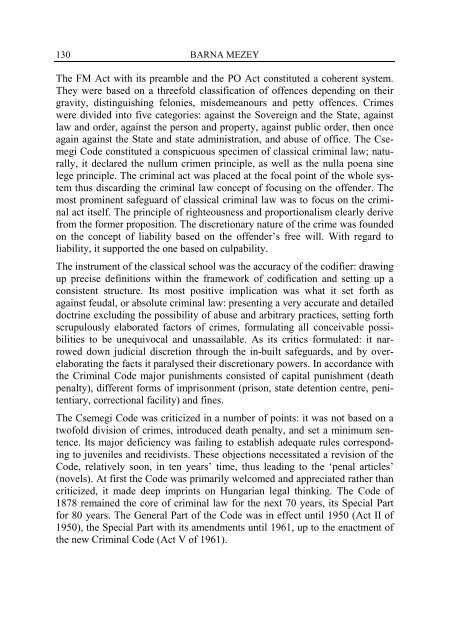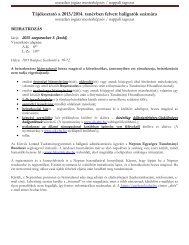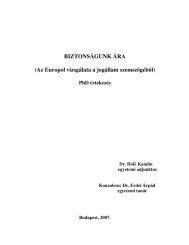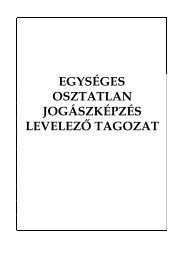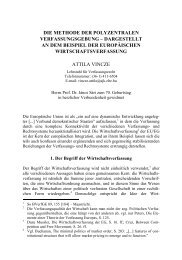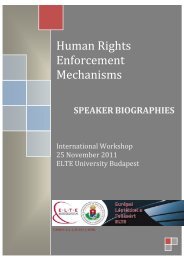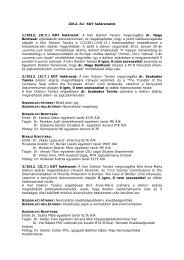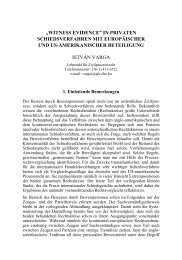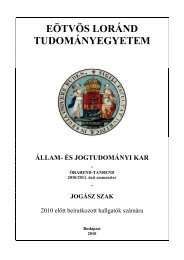5 - Mezey Barna - ELTE Állam- és Jogtudományi Kar
5 - Mezey Barna - ELTE Állam- és Jogtudományi Kar
5 - Mezey Barna - ELTE Állam- és Jogtudományi Kar
Erfolgreiche ePaper selbst erstellen
Machen Sie aus Ihren PDF Publikationen ein blätterbares Flipbook mit unserer einzigartigen Google optimierten e-Paper Software.
130<br />
BARNA MEZEY<br />
The FM Act with its preamble and the PO Act constituted a coherent system.<br />
They were based on a threefold classification of offences depending on their<br />
gravity, distinguishing felonies, misdemeanours and petty offences. Crimes<br />
were divided into five categories: against the Sovereign and the State, against<br />
law and order, against the person and property, against public order, then once<br />
again against the State and state administration, and abuse of office. The Csemegi<br />
Code constituted a conspicuous specimen of classical criminal law; naturally,<br />
it declared the nullum crimen principle, as well as the nulla poena sine<br />
lege principle. The criminal act was placed at the focal point of the whole system<br />
thus discarding the criminal law concept of focusing on the offender. The<br />
most prominent safeguard of classical criminal law was to focus on the criminal<br />
act itself. The principle of righteousness and proportionalism clearly derive<br />
from the former proposition. The discretionary nature of the crime was founded<br />
on the concept of liability based on the offender’s free will. With regard to<br />
liability, it supported the one based on culpability.<br />
The instrument of the classical school was the accuracy of the codifier: drawing<br />
up precise definitions within the framework of codification and setting up a<br />
consistent structure. Its most positive implication was what it set forth as<br />
against feudal, or absolute criminal law: presenting a very accurate and detailed<br />
doctrine excluding the possibility of abuse and arbitrary practices, setting forth<br />
scrupulously elaborated factors of crimes, formulating all conceivable possibilities<br />
to be unequivocal and unassailable. As its critics formulated: it narrowed<br />
down judicial discretion through the in-built safeguards, and by overelaborating<br />
the facts it paralysed their discretionary powers. In accordance with<br />
the Criminal Code major punishments consisted of capital punishment (death<br />
penalty), different forms of imprisonment (prison, state detention centre, penitentiary,<br />
correctional facility) and fines.<br />
The Csemegi Code was criticized in a number of points: it was not based on a<br />
twofold division of crimes, introduced death penalty, and set a minimum sentence.<br />
Its major deficiency was failing to establish adequate rules corresponding<br />
to juveniles and recidivists. These objections necessitated a revision of the<br />
Code, relatively soon, in ten years’ time, thus leading to the ‘penal articles’<br />
(novels). At first the Code was primarily welcomed and appreciated rather than<br />
criticized, it made deep imprints on Hungarian legal thinking. The Code of<br />
1878 remained the core of criminal law for the next 70 years, its Special Part<br />
for 80 years. The General Part of the Code was in effect until 1950 (Act II of<br />
1950), the Special Part with its amendments until 1961, up to the enactment of<br />
the new Criminal Code (Act V of 1961).


